| Wildlife Conservation in Botswana |
|
[Last updated: 02-Aug-2022]
| Start | | | Week 1 | | | Week 2 | | | Week 3 | | | Week 4 | | | Week 5 | | | Week 6 |
Today was a total rest day; absolutely no activities were planned for the
resident volunteers. A fifth volunteer was expected to arrive, but Dicks
returned from the Platjan border without her because she didn't have a
visa for Botswana; she originated from India.
Monday, 26-Sep-2016
Today's two projects: Erosion Control and a Mammal Census.
See Friday, 09-Sep-2016 (of this journal) for details of the erosion control process. The only other thing to write here about the erosion control project is that the journey to and from the site was recorded on camera.
At 14:30, we set off to do a mammal census on the Mopane property. In chronological order along our route (in Google Earth), we saw the following two species of animal:
Today's project: A Day Out to a Game Reserve!
I was up at 03:40, for a 04:00 departure to the Limpopo Lipadi Private Game Reserve. It was dark and a cold morning; even colder sitting in the vehicle with only the canvas sides rolled down for protection against the cold! Being gentlemen, we allowed Caroline to sit in the cab with Driver Dicks.
We made a brief stop about half way, where Caroline and I swapped places; she wanted to stretch out along the seats, and I wanted to get warm!
We arrived at the entrance a few minutes before 06:00, where John, our Lipadi guide, was waiting. His vehicle was even more exposed to the weather than the Land Cruiser we travelled down in (as can be seen in Photo BW-084)! However, blankets were providied for those of us who wanted them, but they didn't help me; I was feeling very cold! It wasn't until about 09:30 that the sun's heat started warming me up!
[Why did I describe the Danish child as spoilt? He explained (during the game reserve tour) that his father had recently died and left this brat with a small fortune! I have no problem with that; it happens every day. What annoyed me was the fact that he admitted that because of his new-found wealth, he didn't need to do anything (work-wise). In fact, he had spent about USD 20,000 with Projects Abroad, spending time in Fiji, Nepal, Botswana, and (soon to be) South Africa. I'm sure he mentioned other destinations, but they escape me.]
During our safari around the reserve, we saw:
* = A Committee, Kettle, or Wake of Vultures [taken from A Comprehensive List of Animal Group Names].
A BBQ had been arranged for lunch, after which, we relaxed by (and sometimes in) a very cold pool (Photo BW-085). It probably felt so cold because it was so hot in the sun. However, once its water was over one's shoulders, it didn't feel so bad!
We left the Lipaldi reserve (Photo BW-086) at about 15:30 for the 2-hour journey back to the Motswiri Camp. But at least it wasn't a cold ride back!
We arrived 'back home' at 17:40. Jane had cooked a very nice vegetable pasta bake. At about 20:00, I retired to my bed - shattered!
 Photo BW-078 |
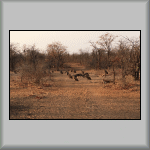 Photo BW-079 |
 Photo BW-080 |
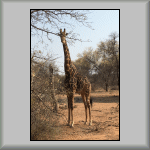 Photo BW-081 |
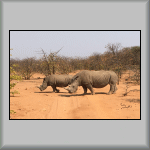 Photo BW-082 |
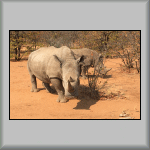 Photo BW-083 |
 Photo BW-084 |
 Photo BW-085 |
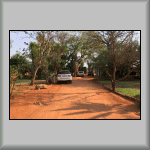 Photo BW-086 |
Today's project: Shopping in Bobonong.
I volunteered to help Sophie do the shopping today. Shopping is normally done on Thursdays, but as Friday was a special event (the 50th anniversary of Botswana becoming independent), it was thought that Thursday would be busy, so Wednesday would be the better option.
We left the camp at 07:00 and our first stop was in Mathathane, to drop Patrick off at his parent's house. Then Sophie and I carried on to Bobonong.
From memory (but not necessarily in the correct order), the first stop in Bobonong was at the vehicle registration office. Sophie thought (and hoped) that at this time of day, the queue would be short; it was!
Next on the To-Do list was to visit the town's refuse tip (Photo BW-087 and Photo BW-088) to offload various bits of camp rubbish and pieces of scrap metal (including some coils of fence wire). In some parts of this tip, rubbish was being burnt, rather than being recycled! Unfortunately, at the time of the visit, this part of Botswana didn't appear to have any recycling facilities; I don't know about other areas of the country. [The radio mast in the background is located at GPS: S21°59'47.40" E28°23'10.30".]
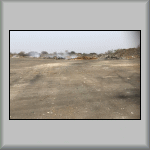 Photo BW-087 |
 Photo BW-088 |
Then it was off to a car spares shop (for a replacement rear light (for one of the vehicles back at camp)), followed by a visit to the butcher (for the week's supply of meat). The butcher told Sophie that the day's supply had not yet arrived.
Next on the tour was the post office, in the centre of the town (Photo BW-089). When we were finished there, we drove to a (very busy) hardware shop to return a window (for Sophie and Jen's house) that had been damaged in transit to their house. It may have been time for lunch (which I think was fish and chips; but the chips were rather pale (under cooked), not golden coloured).
The biggest job in Bobonong was saved until after lunch. We drove over to the Choppies Supermarket to buy the groceries for the week. My first (and only) impression of the store was that it was very similar to a European supermarket. I was kept busy, having to go outside to grab more trolleys (Fr: chariot). In the end, we had completely filled five (5) shopping trolleys! Having previously worked in a supermarket (while at school), I've seen some long till receipts, but not as long as the one produced at this shop! However, I can imagine it would be a lot longer if the camp was full of (16) volunteers!
It was back to the butcher to collect the ordered meat, then, soon after midday, Sophie and I started our journey back to Motswiri (Photo BW-090 and Photo BW-091), arriving back at the camp at 13:30.
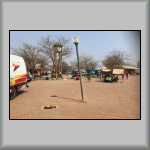 Photo BW-089 |
 Photo BW-090 |
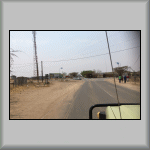 Photo BW-091 |
An hour later, me and the other volunteers, driven by Dicks, left the camp
for a crocodile census along the Limpopo River. At the river, we counted
seventeen crocodiles, one hippopotamus, and six river turtles. On our way
back to camp, we saw five spotted hyenas around the Triple Pans waterhole.
[I often wondered if their presence was captured by the camera traps that
we had previously positioned there!]
Thursday, 29-Sep-2016
Today's two projects: Boom Construction and an Elephant Identification.
Having connected the 'new road' all the way through to the tarmac road (on 13-Sep-2016), a barrier needed to be constructed to stop 'trespassers' from entering the property and taking (among other things) firewood. I think it was more of a deterrent than anything else, because there are many open places along the tarmac road that anyone could use to gain access to the property.
The journey to the construction site had its moments: the camera recording the route (on the Land Cruiser's roof) fell over, the wooden poles on the truck became loose, and a stop was made at a dried river bed to collect some buckets of sand - to make the concrete for the posts. All can be seen in the following video, during which, the camera fell over. The remainder of the film was recorded at a higher speed!

Route
to the Barrier
[1 minute, 07 seconds]
By 10:30, we had a working barrier in place, complete with a No Entry sign, 'borrowed' from the nearby electricity pole!
Back at camp, a rather 'well-fed' and shy lizard (Photo BW-092), about 5"/13 cm in length, came out from under the ramp (in front of the kitchen door). Although it is not perfectly obvious and visible in the photo, its nacre colouring "éetait magnifique"!
Before the elephant census, Sophie gave a presentation on how to identify individual elephants by the different characteristics that elephants have: ears, tails, side views, etc.
We then set off and arrived at the northern waterhole (GPS: S22°19'33" E28°50'50.00") to find it completely dry! Sophie went over to the control panel, switched the pump off and on, Et Voila! the water started flowing! Sorted!
Sophie suggested we visit the Triple Pans waterhole next (GPS: S22°24'10.00" E28°55'14.00"), but as we set off, an elephant must have smelt the fresh water, and came out of nowhere (the bush). It passed us and made its way straight to the water pipe! Minutes later, a second, and more(!), elephants did exactly the same (Photo BW-093).
Instead of going to the Triple Pans waterhole, Sophie reversed and parked the vehicle about 10-15 metres from the waterhole, from where we watched in 'almost' complete (except Danish!) silence! In total, between 20 and 30 elephants (of all ages) came out of the bush to drink; absolutely incredible! Two large cow elephants and a large bull elephant seemed to hog (monopolise) most of the time at the water pipe (Photo BW-094).
We thought that the afternoon might have been elephant-free. In fact, it turned out to be quite the opposite, as the following three photos show:
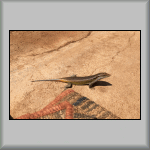 Photo BW-092 |
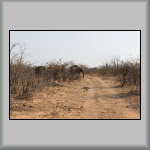 Photo BW-093 |
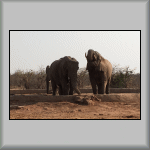 Photo BW-094 |
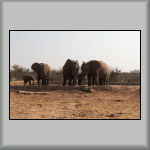 Photo BW-095 |
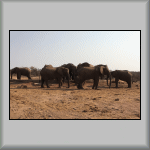 Photo BW-096 |
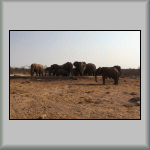 Photo BW-097 |

YouTube - Elephants at a Waterhole
[12 minutes, 55 seconds]
We probably spent about an hour watching them. The following video of the elephants (compiled by film clips from both an iPhone and a Veho Muvi camera (similar to a GoPro), is available from YouTube.
As quick as they appeared, so did they disappear, back into the bush,
once they had quenched their thirst.
Friday, 30-Sep-2016
Today's project: Botswana's Independence Day.
At about 01:00, lions were heard at the entrance to the Motswiri camp. How was it known that the lions were so close to the camp? Dicks took us to the camp entrace and showed us the spoors/footprints of a lion. To provide an idea on how large the footprint was, I placed my (dirty and dusty) right shoe (Size 9½/44) to the right of the footprint (Photo BW-098).
We left the camp at 09:45, bound for Mathathane, to join in the 50th Anniversary Celebrations of Botswana's independence from Great Britain in 1966. [Botswana was previously known as Bechuanaland.]
Once we arrived, we met Jo, who led us to our seats. To my surprise, we were directed to seats on the right-hand side of the town's officials, facing some of the local population (Photo BW-099).
We were back at the camp by 13:45, but not before stopping at, and climbing to the top of one of the koppies en route, to admire the view (Photo BW-100).
 Photo BW-098 |
 Photo BW-099 |
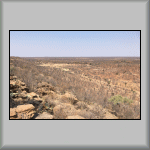 Photo BW-100 |
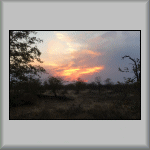 Photo BW-101 |
An inspection of the test borehole a few days ago, showed that it wasn't working. So after a later-than-normal lunch, we went over to replace the 3M waterproof housing (containing a broken wire connection). About an hour or so later, water was flowing again!
The weather was changing. For example, the sunset looked threatening
(Photo BW-101),
the wind had dropped and the evening wasn't cold (26°C). Was this
the 'calm before the storm'?
Saturday, 01-Oct-2016
Today's picnic was planned to be beside the Limpopo River (on the Lekkerpoet property). However, there was a possibility that it wouldn't take place at all! There were thunderstorms around! And, at exactly 10:00, it started raining. Woohoo!
We were wondering if the long-awaited rains had finally arrived? Well, yes and no. Unfortunately, it rained at the camp only enough to dampen down the dust. Therefore, with a rice salad for lunch and with Jo as our guide, we departed shortly after for the Limpopo River.
We set up the picnic spot (Photo BW-102) between the dried-up river bed (Photo BW-104) and an old shack (Photo BW-107).
Suitably refuelled, we set off to explore the river. It was hard to imagine on the day, but when fully flowing, indicated by the water marks on the rocks (Photo BW-103), this river could be more than 2 metres deep. Even during the dry season, rock pools (Photo BW-105) contained life (at various stages)! Over the years (probably millennia!), even smaller pools (Photo BW-106) have been eroded into the bigger (sandstone?) rocks by stones getting caught in the fast-flowing river.
We encountered a few rain showers on the way back to camp, as well as seeing two black eagles (also known as Verreaux's Eagles) in a dead tree (Photo BW-108).
Back at the camp, I had an opportunity to take a photo of an empty carport and the workshop (Photo BW-109).
 Photo BW-102 |
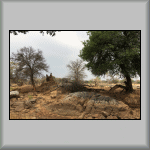 Photo BW-103 |
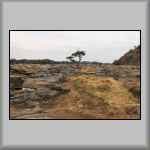 Photo BW-104 |
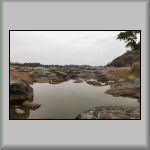 Photo BW-105 |
 Photo BW-106 |
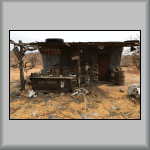 Photo BW-107 |
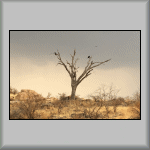 Photo BW-108 |
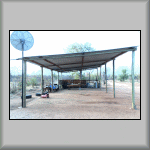 Photo BW-109 |
As the sun set, thunder could be heard to the south. It continued during the evening and throughout the night.
| Previous (Week 3) |
 |
Next (Week 5) |
Click to reveal a Home Page QR Symbol
![]()